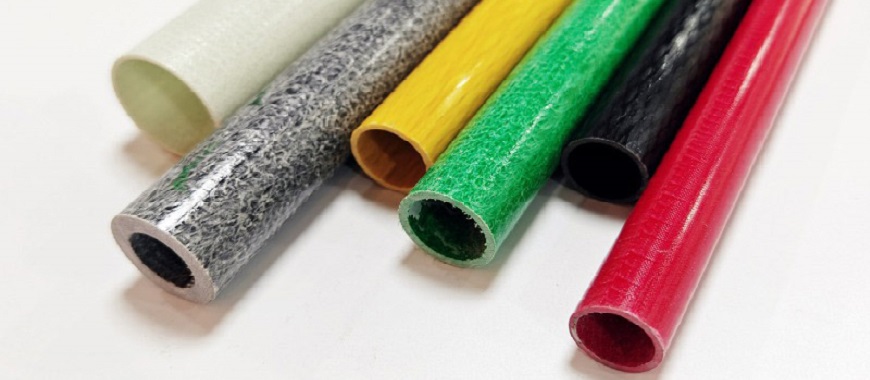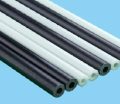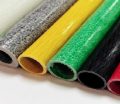
Spun fiberglass tube is widely used for various industrial, residential, and commercial applications. Its lightweight nature and resistance to corrosion make it a preferred choice in environments where durability is essential. These tubes are known for their adaptability, as they can be used both underground and above ground. In many cases, the rigid fiberglass tube is also utilized in similar applications, offering enhanced strength and rigidity for projects that require a more solid structural support. To meet specific project needs, it’s important to work with a fiberglass tube factory that can provide customized spun fiberglass tube sizes. Spun fiberglass tube sizes are available in standard dimensions, but customized options can also be provided to meet specific project needs. With growing demand, spun fiberglass tube near me searches have become popular for easy sourcing. These tubes offer a cost-effective solution, making them attractive for long-term installations. Whether installed as part of ductwork or standalone infrastructure, spun fiberglass tube ensures excellent performance across applications.
Broad View of Spun Fiberglass Tube
What Is a Spun Fiberglass Tube?
A spun fiberglass tube is a structural component made from glass fibers and resin. It is manufactured using a specialized process where fibers are spun and bonded together to create lightweight, durable tubes. These tubes provide both strength and flexibility, making them suitable for various uses. Different from tapered fiberglass tubes, which gradually reduce in diameter from one end to the other, spun fiberglass tubes maintain a consistent shape throughout their length.
Definition and Manufacturing Process
- Spun fiberglass tube is created through filament winding or centrifugal spinning techniques.
- The process involves layering fibers with resin to achieve the desired thickness and strength.
- Curing occurs under controlled temperatures to ensure consistent quality and long-term performance.
- Tubes can be customized for different projects by adjusting fiber composition and resin types.
Common Applications in Industrial and Residential Projects
- Industrial Ductwork: Offering corrosion resistance for chemical environments.
- Underground Ducting: Applied in water management systems to prevent pipe degradation over time.
- Residential Construction: Supports infrastructure like fencing, piping, and electrical conduits.
- Exhaust Systems: Incorporated in industrial facilities where heat and chemical resistance are required.
Why Choose Spun Fiberglass Tube?
The spun fiberglass tube provides significant benefits that make it a preferred option for many industries. Its unique properties ensure long-term reliability in different environments.
Benefits of Spun Fiberglass Tube
- Lightweight: Easy to transport, install, and handle during both underground and above-ground applications.
- Durable: Resistant to weathering, chemicals, and physical impact, ensuring long-term stability.
- Corrosion-Resistant: Ideal for use in chemical environments, preventing rust and material degradation.
- Low Maintenance: Requires minimal upkeep, reducing overall maintenance costs.
Environmental Adaptability for Underground and Above-Ground Applications
- Suitable for underground ducting due to its resistance to soil moisture and corrosion.
- Performs well above ground, as it withstands exposure to sunlight and temperature variations.
- Case studies show improved longevity when compared to traditional materials like metal or PVC.
- Research highlights its use in chemical processing plants, where corrosion protection is critical.
This combination of strength, adaptability, and durability makes the spun fiberglass tube an excellent solution across different projects.
Fiberglass Bath Tube Benefits for Your Home Renovation
Spun Fiberglass Tube Sizes and Availability
Spun fiberglass tube sizes and availability play a crucial role in meeting the needs of various industries. Having access to standard and custom sizes ensures these tubes can adapt to specific project requirements, enhancing their utility and performance. With the right sizing, spun fiberglass tubes provide efficient solutions in both industrial and residential applications.
Standard Spun Fiberglass Tube Sizes
Standard sizes of spun fiberglass tube cater to a range of industrial, commercial, and residential uses. These sizes meet typical project needs while ensuring ease of installation and material optimization.
Overview of Common Tube Sizes for Different Needs
- Small Sizes (1–3 inches):
Ideal for lightweight projects, electrical conduits, or small-scale ducts. - Medium Sizes (4–12 inches):
Suitable for underground drainage systems, ventilation ducts, and support columns in residential construction. - Large Sizes (13–24 inches):
Commonly used in industrial exhaust systems and chemical fume ducts. - Extra-Large Sizes (25 inches or more):
Preferred for large-scale infrastructure, such as water pipelines or factory air circulation systems. - Wall Thickness Variations:
Thickness ranges from 1 mm to several inches, depending on the level of structural strength required.
Custom Sizing Options for Specialized Projects
- Tailored Lengths: Custom-cut tubes reduce material waste and ensure precise fit for specific installations.
- Variable Diameters: Diameters can be adjusted for niche projects like chemical processing or underground ducting.
- Reinforced Layers: Additional layers of fiberglass can be applied to enhance durability for high-stress applications.
- Tapered Ends: Some projects may require tapered ends for easy connections with other components.
- Special Coatings: Coatings may be added for enhanced resistance to extreme temperatures or chemical exposure.
Finding Spun Fiberglass Tube Near Me
At GangLong Fiberglass, we take pride in offering high-quality spun fiberglass tubes that meet the demands of diverse industries. We understand the importance of accessibility, and our goal is to ensure these products are readily available to customers seeking reliable solutions.
Guidance on How to Locate Suppliers or Distributors
- Direct Contact: Start by reaching out to our local representatives to discuss your project needs and tube specifications.
- Regional Warehouses: GangLong Fiberglass operates in multiple locations, making it easy to find spun fiberglass tube near me quickly.
- Bulk Ordering Services: If you need larger quantities, we provide streamlined bulk order options through local distributors.
- Flexible Delivery: Customers can choose between local pick-up and fast shipping services, depending on the project timeline.
Tips for Checking Local Availability and Ordering Options
- Plan Ahead: Early communication with suppliers ensures the right sizes are in stock before the project begins.
- Request Samples: For custom designs, order samples to verify tube dimensions and performance characteristics.
- Inquire About Lead Times: Custom sizes may require longer lead times, so planning accordingly avoids project delays.
- Ask About Discounts: Bulk orders often come with price reductions, making it more economical to order in larger quantities.
- Review Regional Distributors: Check with multiple distributors to compare stock availability and delivery times.
GangLong Fiberglass ensures that customers have access to a broad range of spun fiberglass tube sizes. Whether for standard applications or custom projects, we provide expert guidance and flexible ordering solutions to meet every project’s requirements efficiently.
Pricing and Purchasing Spun Fiberglass Tube
The pricing and purchasing process for spun fiberglass tube plays a significant role in project planning and execution. Understanding the factors influencing costs and identifying reliable sources helps ensure you get the right product for the best value. Spun fiberglass tubes are available in various configurations, and their price is determined by multiple factors, including material quality, customization, and market conditions. Just as fiberglass insulation prices can fluctuate based on similar factors like material grade and demand, the cost of spun fiberglass tubes is also subject to these variables, making it important to stay informed and compare options before making a purchase.
Spun Fiberglass Tube Price Factors
Several elements contribute to the pricing of spun fiberglass tube. Material quality, size variations, and additional customization options directly impact the total cost. Additionally, market fluctuations and seasonal trends affect pricing, which buyers should monitor when planning purchases.
Material Quality, Size, and Customization Affecting Costs
- Resin Type: Tubes reinforced with higher-grade resins, such as vinyl ester or epoxy, are more expensive but offer superior performance.
- Fiber Content: Tubes with higher fiber density provide better strength but come at a higher cost.
- Size Variations: Larger diameters or thicker walls require more material, which increases both production time and cost.
- Customization Options: Specialized designs, such as tapered ends or reinforced layers, involve extra labor and manufacturing complexity.
- Compliance Standards: Tubes meeting industry certifications may be priced higher due to stringent manufacturing processes.
Market Trends and Seasonal Price Variations
- Increased Demand During Peak Seasons: Construction and industrial projects tend to increase in warmer months, driving up demand and prices.
- Raw Material Costs: Fluctuations in the prices of fiberglass and resin materials directly affect the final cost of the tubes.
- Supply Chain Factors: Global logistics challenges can lead to delays and price increases, especially for bulk orders.
- Currency Exchange Rates: International purchases may see price changes based on currency fluctuations.
- Economic Conditions: Prices can shift in response to broader economic trends, including inflation and market demand.
Where to Find Spun Fiberglass Tube for Sale
Identifying reliable sources for spun fiberglass tube ensures a smooth purchasing process. Buyers have various options, including direct purchases from manufacturers or distributors and bulk ordering services. Each option offers specific advantages, depending on the project requirements.
Sources for Direct and Bulk Purchases
- Manufacturers: Direct purchases from manufacturers often provide better pricing for custom orders.
- Local Distributors: Regional distributors stock standard sizes and can offer quick delivery for smaller quantities.
- Bulk Suppliers: Bulk purchases reduce per-unit costs and ensure consistent supply for large projects.
- Industrial Supply Chains: Some companies offer specialized products along with accessories and installation services.
- Secondary Markets: Surplus stock or refurbished tubes can provide cost-effective alternatives, although availability may vary.
Important Considerations When Buying Online or Locally
- Shipping Costs: Online purchases may involve additional fees for transportation, especially for large or heavy tubes.
- Lead Times: Custom orders may require longer processing times, so ordering in advance helps avoid project delays.
- Product Specifications: Verify that the tube specifications match project requirements, including size, strength, and coating needs.
- Return Policies: Choose suppliers with clear return policies to ensure flexibility in case of order adjustments.
- Local Availability: Buying locally can reduce shipping times and offer the chance to inspect products before purchase.
Informed purchasing decisions help ensure that spun fiberglass tube investments align with project goals. Whether ordering small quantities or placing bulk orders, careful consideration of price factors and sourcing options maximizes value and ensures timely delivery.
How to Choose the Perfect Fiberglass Bondage Tube
Applications of Spun Fiberglass Tube in Ductwork Systems
Spun fiberglass tube plays an essential role in ductwork systems, offering advantages in both underground and above-ground installations. Its lightweight, durable, and corrosion-resistant properties make it a reliable solution for various ductwork applications. From HVAC systems to underground piping, spun fiberglass tube ensures long-term performance in demanding environments. This section explores its use in underground ducting and compares fiberglass tubes with alternative materials like PVC.
Using Spun Fiberglass Tube in Underground Ducting
Spun fiberglass tube is widely utilized in underground ducting systems for its ability to withstand challenging conditions. Its structural properties provide durability and efficiency, ensuring that it performs optimally over extended periods.
Role in Efficient HVAC Installations and Underground Systems
- Lightweight Construction: Spun fiberglass tube simplifies installation by reducing the need for heavy equipment, lowering labor costs and installation time.
- Insulation Capabilities: Its inherent insulation properties help maintain consistent temperatures in HVAC systems, increasing energy efficiency.
- Moisture Resistance: The tube resists moisture infiltration, preventing mold or corrosion in underground ductwork systems.
- Compatibility with HVAC Systems: Its smooth interior surface reduces air resistance, enhancing airflow efficiency and minimizing energy consumption.
Importance of Corrosion Resistance in Underground Applications
- Protection from Soil Chemicals: Underground ducts often encounter corrosive elements in soil, which spun fiberglass tube effectively resists.
- Long-Term Durability: Corrosion resistance extends the lifespan of the system, reducing the need for frequent replacements.
- Improved Environmental Performance: Non-corroding materials prevent leaks that could contaminate soil and surrounding environments.
- Minimal Maintenance Requirements: Unlike metal ducts, fiberglass tubes require little maintenance, further lowering operational costs.
Alternatives to PVC Underground Ductwork
PVC has long been used in underground duct systems, but spun fiberglass tube offers distinct advantages in specific scenarios. The choice between fiberglass and PVC depends on the project’s demands, environmental factors, and long-term goals.
Comparison of Fiberglass with Other Materials Like PVC
- Strength and Flexibility: Spun fiberglass tube provides enhanced flexibility, making it less likely to crack under pressure compared to rigid PVC.
- Temperature Resistance: While PVC can become brittle in extreme temperatures, fiberglass maintains stability across a broader temperature range.
- Environmental Impact: Fiberglass is non-toxic and does not release harmful chemicals, whereas PVC may degrade and release pollutants over time.
- Lifespan: Fiberglass offers superior durability, especially in harsh conditions, which makes it more suitable for long-term applications.
Suitability of Fiberglass for Long-Term Underground Installations
- Extended Service Life: Spun fiberglass tube retains its structural integrity over time, reducing the need for costly replacements.
- Resistance to Physical Damage: Unlike PVC, fiberglass is less prone to cracking from ground movements or heavy loads.
- Adaptability to Custom Designs: Fiberglass tubes can be tailored to specific project needs, ensuring compatibility with other underground systems.
- Case Studies in Industrial Installations: Research shows that fiberglass performs better than PVC in chemical environments, such as industrial ducts carrying corrosive gases.
Spun fiberglass tube provides several benefits in underground ducting , making it a preferred alternative to PVC in many situations. Its durability, flexibility, and resistance to environmental stressors make it ideal for long-term applications, ensuring reliable performance in various conditions.
Get Affordable Fiberglass Composite Tube for All Purposes
Specialty Spun Fiberglass Tube Applications
Spun fiberglass tube plays a key role in HVAC systems and other specialized duct applications. Round fiberglass ducts offer unique benefits that enhance performance, reduce energy consumption, and ensure durability in demanding environments. Their lightweight construction and corrosion resistance make them highly suitable for both underground and above-ground installations. Proper installation and maintenance further optimize the performance of these tubes, extending their lifespan and minimizing operational issues.
Spun Fiberglass Tube for HVAC Systems
Round fiberglass ducts made from spun fiberglass tube are widely employed in HVAC solutions due to their energy-efficient properties and adaptability. These tubes provide effective air handling and insulation, supporting comfortable indoor environments across various settings.
Use of Round Fiberglass Ducts for HVAC Solutions
- Commercial HVAC Systems: Fiberglass tubes transport conditioned air efficiently in large office spaces, retail centers, and hotels.
- Residential Applications: Homeowners use fiberglass ducts to improve airflow in heating, ventilation, and air conditioning systems.
- Industrial Environments: Factories and warehouses rely on fiberglass ducts for ventilation in areas exposed to dust, fumes, or chemicals.
- Cleanroom Facilities: Hospitals and laboratories utilize fiberglass ducts to maintain sterile environments and control air quality.
- Retrofit Projects: Fiberglass tubes are suitable for upgrades of outdated metal ductwork systems to improve performance and energy efficiency.
Benefits of Using Fiberglass Ducts for Energy Efficiency
- Superior Insulation: Fiberglass tubes reduce heat transfer, preventing energy losses and maintaining consistent temperatures.
- Low Air Resistance: The smooth interior of the spun fiberglass tube minimizes air resistance, optimizing airflow throughout the system.
- Corrosion Resistance: Unlike metal ducts, fiberglass does not rust, ensuring long-lasting performance in humid environments.
- Reduced Maintenance Costs: Fiberglass ducts require minimal upkeep, lowering long-term operational expenses.
- Environmental Sustainability: The extended lifespan and energy-saving features of fiberglass ducts contribute to eco-friendly HVAC systems.
Installation and Maintenance of Fiberglass Ducts
Proper installation and regular maintenance are essential for maximizing the performance of spun fiberglass tube in HVAC and ductwork systems. Following specific guidelines ensures that the ducts function efficiently and remain free from damage.
Guidelines for Proper Installation
- Pre-Installation Inspection: Inspect all components for defects or damage before beginning installation to avoid issues later.
- Accurate Measurement: Ensure precise measurements to fit the fiberglass ducts correctly into the space, preventing gaps or airflow blockages.
- Secure Connections: Use appropriate sealing materials at joints and connections, including where fiberglass tube end fittings meet the ducts, to prevent air leaks and maintain efficiency. Ensure that the fittings are tightly secured to avoid any gaps that could reduce system performance.
- Support Systems: Install adequate support brackets to prevent sagging, especially for large or long duct runs.
- Adherence to Safety Standards: Follow industry safety guidelines to ensure proper handling and installation procedures.
Regular Maintenance Tips for Underground and Above-Ground Ducts
- Visual Inspections: Regularly check for cracks, leaks, or physical damage that may impact performance.
- Cleaning Schedule: Implement periodic cleaning to prevent dust buildup and ensure optimal airflow within the ducts.
- Monitor Moisture Levels: Inspect for signs of moisture infiltration, particularly in underground ducts, to prevent mold growth.
- Inspect Seals and Joints: Check that seals remain intact over time, reapplying sealants if necessary to prevent air leakage.
- System Testing: Perform airflow tests periodically to confirm that the ducts are functioning efficiently and free from blockages.
Maintaining spun fiberglass tube systems properly ensures efficient HVAC operation, preventing costly repairs or system failures. With minimal maintenance and correct installation, these ducts offer long-term reliability for both residential and industrial applications.

As the editor of GangLong Fiberglass, I have years of experience and in-depth research, focusing on cable tray products, fiberglass solutions, and grille systems. I incorporate years of industry insights and practical experience into every content, committed to promoting the progress of the industry. At GangLong Fiberglass, my commitment is reflected in every product, from innovative cable trays to durable fiberglass solutions and sturdy grille systems. As an authoritative voice in the industry, my goal is to provide valuable information to professionals and businesses and promote forward-looking solutions.


